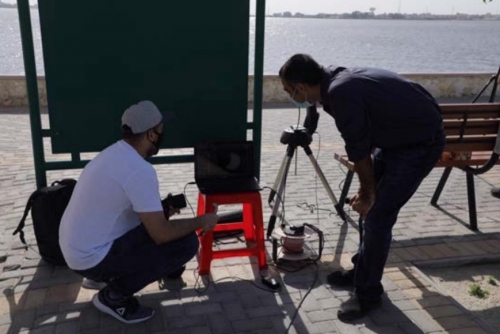Partial eclipse spectacle
TDT| Manama
Skywatchers all over Bahrain were treated to a partial solar eclipse yesterday as the moon drifted across the face of the sun in a rare occurrence on the longest day of the year. The eclipse was seen from a little after 7am and it lasted until around 10am, according to witnesses. The peak of the eclipse happened at roughly 8.30am, they added.
In support of nation-wide efforts to mitigate the spread of the coronavirus (COVID-19), there were no large or formal gatherings organised to monitor the eclipse, although many observed from public places while taking into account COVID-19 precautionary measures.
A number of front-liners at a local quarantine centre were even able to relish the experience, having been provided with special glasses by the Northern Governorate to watch the eclipse, it was revealed on social media. Others enjoyed the phenomenon from the safety of their homes or from building rooftops, while some followed it live online.
“I’ve been taking photos of eclipses and supermoons here in Bahrain for almost five years now and it is a soulful pleasure for my eyes to witness the amazing wonders of such phenomenon,” Bahrain resident Kharisma Privado told TDT. “It has been my hobby to note down all these once-in-alifetime events and make sure I wouldn’t miss them. I can’t wait to see another astronomical spectacle soon.”
Solar eclipses on the summer solstice are rare. The last one was in June 2001. Bahrain was one of a number of locations across the Middle East from where the partial eclipse could be seen. In other locations across parts of the eastern hemisphere, including East Asia, South Asia and Africa, the true “ring of fire”–a shimmering ring of light–flashed into view.
A “ring of fire” eclipse that falls exactly in midsummer, whether in the northern or southern hemisphere, is even more uncommon. There have been none in at least 100 years, according to Reuters calculations based on NASA data. The next one is in 2039, and then in 2392.
Unlike in a total eclipse, the moon in an annular, or ring-like, eclipse is unable to completely cover the sun, leaving a thin halo of light at its maximum phase. Such an eclipse happens when the moon is farther away in its elliptical orbit around the Earth, appearing smaller as a result.
Elsewhere in the continent, hundreds gathered in an open space in Chiayi in southern Taiwan, one of the locations in Asia where the annular eclipse was visible, according to Reuters. “I’m more than 50 years old, so it’s great that I could see this,” said retiree Zhuang Yuhui, who travelled to Chiayi from nearby Taichung city.
“I’m beyond excited.” In Taipei, groups of people gathered to view the eclipse through tinted glasses and their phones as the sky turned eerily darker. “It’s an astronomical miracle,” said Elisa Chen.
Related Posts

